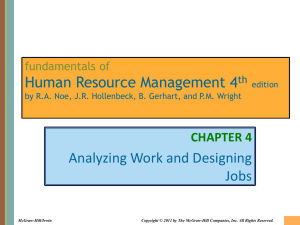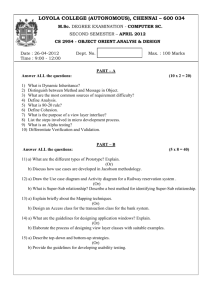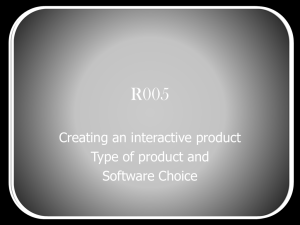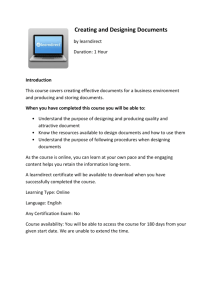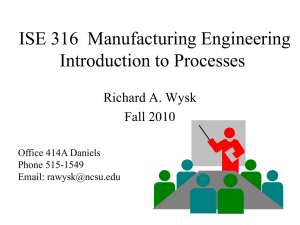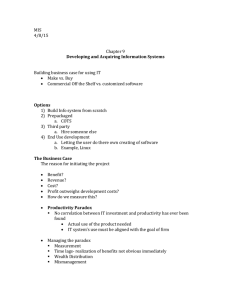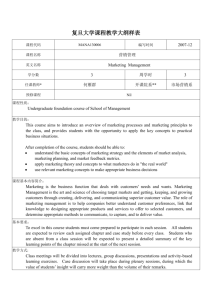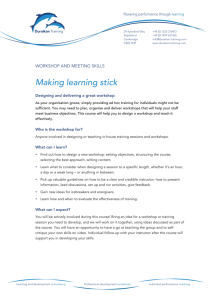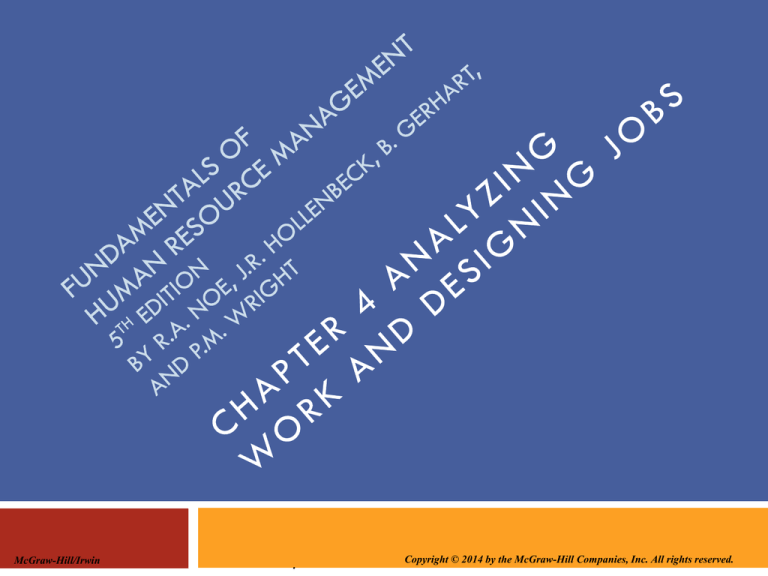
McGraw-Hill/Irwin
.
Copyright © 2014 by the McGraw-Hill Companies, Inc. All rights reserved.
Need to Know
1.
2.
3.
4.
5.
Elements of work flow analysis and how work flow
is related to an organization’s structure.
How to obtain information for a job analysis.
Elements and trends in job analysis and their
significance in HRM.
Methods for designing a job so that it can be
done efficiently and motivating.
How organizations apply ergonomics to design
safe jobs and plan for mental demands of a job.
4-2
Work Flow In Organizations
• Process of
analyzing tasks
necessary for
production of a
product or
service.
• Set of job
duties
performed by a
particular
person.
• Set of related
duties.
4-3
Figure 4.1: Developing a Work Flow
Analysis
4-4
Work Flow Design and Organization’s
Structure
Within an organization, units and individuals must
cooperate to create outputs.
The organization’s structure brings together
people who must collaborate to efficiently produce
desired outputs.
Centralized
Decentralized
Functional
Product or Customer
4-5
Firefighters work as a team.
They and their equipment
are the inputs and the output
is an extinguished fire and
the rescue of people and
pets.
In any organization or team,
workers need to be crosstrained in several skills to
create an effective team.
4-6
Job Analysis
Job Analysis
Process of getting
detailed information
about jobs.
Job
Descriptions
Job
Specifications
4-7
Job Descriptions
Job Description: a list of tasks, duties, and
responsibilities (TDRs) that a particular job entails.
Key components:
Job Title
Brief description of the TDRs
List of the essential duties with detailed specifications of
the tasks involved in carrying out each duty
4-8
Figure 4.2: Sample Job Description
4-9
Job Specifications
Job Specification: list of knowledge, skills,
abilities, and other characteristics (KSAO needed
to perform a particular job).
Knowledge:
factual or procedural information
necessary for successfully performing a task.
Skill: an individual’s level of proficiency at
performing a particular task.
Ability: a general enduring capability that an
individual possesses.
Other Characteristics: job-related licensing,
certifications, or personality traits.
4-10
Figure 4.3: Sample Job Specifications
4-11
Sources of Job Information
The incumbents – people who currently hold the
position in the organization.
Dictionary of Occupational Titles (DOT) – published
by the U.S. Department of Labor
Occupational Information Network (O*NET) – an
online job description database developed by the
Labor Department
4-12
4-13
Position Analysis Questionnaire (PAQ)
What is it?
A standardized job
analysis questionnaire
containing 194 questions
about work behaviors,
work conditions, and job
characteristics that apply
to a wide variety of jobs.
Key sections:
1.
2.
3.
4.
5.
6.
Information input
Mental processes
Work output
Relationships with
other persons
Job context
Other characteristics
4-14
Fleishman Job Analysis System
What is it?
Job analysis technique
that asks subject-matter
experts to evaluate a job
in terms of the abilities
required to perform the
job.
Categories of abilities:
•
•
•
•
•
Written comprehension
Deductive reasoning
Manual dexterity
Stamina
Originality
4-15
Figure 4.4: Example of an Ability from Fleishman
Job Analysis System
4-16
Importance of Job Analysis
Job analysis is so
important to HR managers
that it has been called the
building block of all HRM
functions.
Almost every HRM
program requires some
type of information
determined by job
analysis.
•
•
•
•
•
•
•
Work redesign
HR planning
Selection
Training
Performance appraisal
Career planning
Job evaluation
4-17
Table 4.1: competency model
Project Manager
Competencies
Proficiency Ratings
Organizational & Planning Skills
Ability to establish priorities on projects and
schedule activities to achieve results
1—Below Expectations
2—Meets Expectations
3—Exceeds Expectations
Communications
Ability to build credibility and trust through
open and direct communications with
internal and external customers.
1—Below Expectations
2—Meets Expectations
3—Exceeds Expectations
Financial & Quantitative Skills
Ability to analyze financial information
accurately and set financial goals that have
a positive impact on company’s bottom line
and fiscal objective
1—Below Expectations
2—Meets Expectations
3—Exceeds Expectations
4-18
Trends in Job Analysis
Organizations are being viewed as a field of work
needing to be done, rather than as a set series of jobs
held by individuals.
“Dejobbing” – designing work by project rather than
jobs.
4-19
Job Design
Job Design: the process of defining how work will be
performed and what tasks will be required in a
given job.
Job Redesign: a similar process that involves
changing an existing job design.
To design jobs effectively, a person must thoroughly
understand:
job itself (through job analysis) and
its place in the units work flow (work flow analysis)
4-20
Figure 4.5: Approaches to Job Design
4-21
Designing Efficient Jobs
Industrial Engineering: study of jobs to find simplest
way to structure work to maximize efficiency.
Reduces complexity of work.
Allows almost anyone to be trained quickly and easily
perform the job.
Used for highly specialized and repetitive jobs.
4-22
Designing Jobs That Motivate: The Job
Characteristics Model
1.
2.
3.
Skill variety – extent to which a job requires a
variety of skills to carry out tasks involved.
Task identity – degree to which a job requires
completing a “whole” piece of work from
beginning to end.
Task significance – extent to which the job has an
important impact on lives of other people.
4-23
Designing Jobs that Motivate: Job
Characteristics Model
4.
5.
Autonomy – degree to which the job allows an
individual to make decisions about the way work
will be carried out.
Feedback - extent to which a person receives clear
information about performance effectiveness
from the work itself.
4-24
Figure 4.6: Characteristics of a Motivating
Job
4-25
Designing Jobs That Motivate
Job Enlargement
Job Enlargement - Broadening types of tasks
performed in a job.
Job Extension - Enlarging
jobs by combining several
relatively simple jobs to
form a job with a wider
range of tasks.
Job Rotation - Enlarging
jobs by moving employees
among several different
jobs.
4-26
Designing Jobs That Motivate
Job Enrichment
•
•
•
Empowering workers
by adding more
decision-making
authority to jobs.
Based on Herzberg’s
theory of motivation.
Individuals motivated
more by intrinsic
aspects of work.
Self-Managing Work Teams
Have authority for an
entire work process or
segment
Team members
motivated by
autonomy, skill variety,
and task identity.
4-27
Test Your Knowledge
Adding more tasks to an existing job is called
____________, while adding more decisionmaking authority to jobs is called _________.
A.
B.
C.
D.
Job extension; job rotation
Job rotation; job enrichment
Job enlargement; job enrichment
Job enlargement; job rotation
4-28
Designing Jobs That Motivate Flexible
Work Schedules
Flextime
A scheduling policy in
which full-time employees
may choose starting and
ending times within
guidelines specified by the
organization.
•A work schedule that
allows time for community
and family interests can
be extremely motivating.
•
Job Sharing
A work option in which
two part-time employees
carry out the tasks
associated with a single
job.
•Enables an organization
to attract or retain valued
employees who want more
time to attend school or
take care of family
matters.
•
4-29
Figure 4.7:
Alternatives to
8-to-5 Job
4-30
Designing Jobs That Motivate Telework
Telework – the broad term for doing one’s work away
from a centrally located office.
• Advantages to employers include:
•
•
less need for office space
greater flexibility to employees with special needs
Easiest to implement for managerial, professional,
or sales jobs.
Difficult to set up for manufacturing workers.
4-31
Designing Ergonomic Jobs
•
•
Ergonomics – study of interface between
individuals’ physiology and characteristics of
physical work environment.
Goal is to minimize physical strain on the worker
by structuring physical work environment around
the way the human body works.
Redesigning work to make it more worker- friendly
can lead to increased efficiencies.
4-32
Although employers in all
industries are supposed to
protect workers under the
OSHA “general duty” clause,
nursing homes, grocery stores,
and poultry- processing plants
are the only three industries
for which OSHA has published
ergonomic standards.
4-33
Designing Jobs That Meet Mental
Capabilities and Limitations
•
•
•
•
Work is designed to reduce informationprocessing requirements of the job.
Workers may be less likely to make mistakes or
have accidents.
Simpler jobs may be less motivating.
Technology tools may be distracting employees
from their primary task resulting in increased
mistakes and accidents.
4-34
Ways to Simplify a Job’s Mental
Demands
Limit amount of information and memorization that
the job requires.
Organizations can provide:
adequate lighting
easy-to-read gauges and displays
simple-to-operate equipment
clear instructions
4-35
Summary
Work flow analysis identifies:
•
•
amount and quality of a work unit’s outputs
work processes required to produce these outputs
inputs used to carry out processes and produce outputs
Within an organization, units and individuals must
cooperate to create outputs, and organization’s
structure brings people together for this purpose.
Job analysis is the process of getting detailed
information about jobs.
4-36
Summary
Job analysis includes preparation of
Job descriptions
Job specifications
Information for analyzing an existing job often
comes from incumbents and their supervisors.
The U.S. Department of Labor provides
information:
Dictionary of Occupational Titles
Occupational Information Network (O*NET)
4-37
Summary
The nature of work and job design is changing.
Viewing organizations in terms of a field of work
needing to be done instead of specific job descriptions
Organizations are adopting project-based structures
and teamwork, which also require flexibility and ability
to handle broad responsibilities.
The basic technique for designing efficient jobs is
industrial engineering.
4-38
Summary
According to the Job Characteristics Model, jobs are more
motivating if they have greater skill variety, task identity, task
significance, autonomy, and feedback.
Ways to create such jobs include:
Job Enlargement
Job Rotation
Job Enrichment
Self-managing work teams offer greater skill variety and task
identity
Flexible work schedules and telework offer greater autonomy
4-39
Summary
Goal of ergonomics is to minimize physical strain on
the worker by structuring the physical work
environment around the way the human body works
Employers may seek to reduce the mental as well as
physical strain and reduce errors and accidents.
Job design may limit amount of information and
memorization involved.
Technology tools may actually cause more distractions, errors,
and accidents.
4-40

